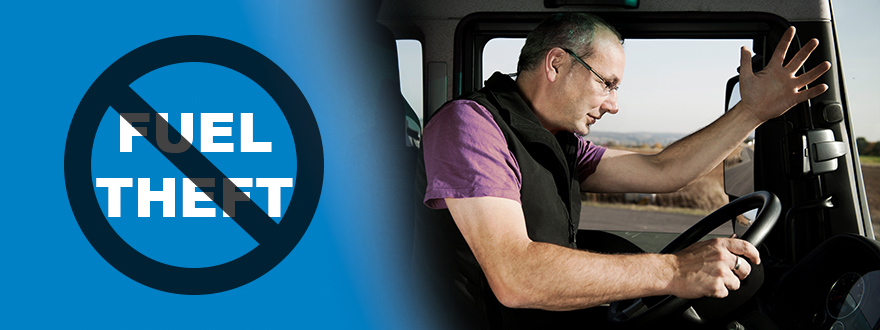Stop internal fuel theft with fuel tracking & analytics.

When every drop counts, track every drop.
Fuel accounts for about 24 percent of a fleet’s annual budget, and keeping each vehicle’s tank full is no small cost. For example, on average one Class 8 semi-truck travels almost 63,000 miles per year. At an average fuel economy of 5.29 MPG and an average diesel price of about $6.00 a gallon, keeping that one big rig fueled costs more than $30,000 a year; that’s the planned cost.
As fuel prices have risen, so have the rates of internal fuel theft, a crime of small opportunities that add up and are hard to absorb, especially for smaller companies. But the right fuel tracking and analytics solution, combined with a high-definition GPS tracking solution, captures the data you need to spot the red flags and investigate further.
Deploy the right tech to spot red flags.
Internal fuel thieves leave tracks in the vehicle’s fuel data. Use the fuel tracking and analytics solution, in conjunction with the GPS tracking solution, to analyze real-world fuel usage, vehicle movements and driver behavior. Identify unusual activity and trends, so you can investigate with facts in hand.
If you monitor your heavy-duty fleet vehicles using GPS data fed through an on-board telematics device, integrate a fuel tracking and analytics solution that measures more than just MPG. Choose one that includes a report function for matching fuel card transactions with vehicle location, dates and times.
Analyze vehicle data, GPS and fuel use for a complete picture of:
- where that vehicle was driven
- where and when the driver stopped to refuel, and how much was purchased
- type of fuel purchased compared to the type of fuel the vehicle takes
- amount of fuel purchased compared to how much was used, the tank’s capacity and trip length
- route and traffic conditions that might affect efficiency
- location, date and duration of excessive idling that might explain additional fuel usage
- refueling locations, including stops at—or outside of—approved, geofenced stations
As you analyze the data, look for events and activities out of the ordinary, or that can’t be readily explained. Don’t automatically assume these events are theft, but ask informed questions to get to the bottom of what’s draining your tanks.
| Red flag | What it could signal |
|---|---|
| Purchasing more fuel than the vehicle’s tank will hold | Filling up portable gas cans for personal use or to sell on the side |
| Unplanned, off-route stops | Filling up personal vehicle, or filling gas cans and dropping them off for sale on the side |
| Distinct drop in fuel efficiency | Partially filling up the fleet vehicle’s tank to top off personal gas tanks or dummy tanks with the rest |
| Purchasing the wrong fuel type for that vehicle | Buying fuel meant to go elsewhere such as personal vehicle or personal fuel containers, or for storing in dummy tanks for sale on the side |
| Purchase locations that don’t match vehicle location or trip | Using fleet funds to fill personal gas cans, dummy tanks or other portable fuel containers |
| Making more fueling stops than were made by another driver on the same exact route (or even going off route) | Still needs to complete the assigned trip, so makes additional stops to refuel the vehicle and possibly steal more fuel for personal profit or use |
Look at the data in real-world context.
Scenario A: Too much for one tank.
While on his designated route hauling goods, Driver A stops at an off route fueling station to fill up his Class 8 semi-truck. While there, he also uses the company gas card to fill up a hidden bladder tank prepositioned at that specific station.
What the data shows: Using the fuel tracking and analytics solution, you see that the amount of fuel purchased at that stop exceeded that truck’s tank capacity. By looking at vehicle GPS location data, you also see how far off route the driver went to reach that specific station.
Scenario B: Now it’s personal.
Driver B uses the company van to run personal errands. In addition to using fleet fuel for personal use, the driver stops at his home to pick up personal gas cans, fills them up on the company card and takes them back home. All while assuming you don’t track that van’s activities because it’s a light-duty vehicle.
What the data shows: If you track that van, its GPS and historical path data will reveal that the driver:
- used fleet fuel for personal drive time
- potentially stole fuel using company funds for personal purposes
By installing a small light-duty tracking device, you can look at that van’s date, location, time and path data to verify the driver’s unauthorized personal drivetime. And ask why he stopped by his home.
Track small vehicles to detect often overlooked theft.
Using the company car for unauthorized personal use constitutes fuel theft; plain and simple.
Light-duty vehicles such as vans, sedans and small trucks are vulnerable because drivers can take them on smaller trips in areas that heavy-duty vehicles such as semis can’t navigate. Plus, many fleets don’t think tracking these vehicles is worth the effort. As a result, they’re easy targets for small-time internal fuel theft that adds up.
Equip your fleet’s light-duty vehicles with a small, plug-and-play light-duty tracking device to see:
- when that vehicle is used for unauthorized personal use
- makes unauthorized, unnecessary stops at fueling stations
- is driven off-route to locations such as employee homes
All of which could signal internal fuel theft and provide your basis for further investigation.
Ask for explanations before making accusations.
Fuel prices are hitting everyone hard, including employees trying to keep their own household afloat. But not everyone is out to rob you. Your driver may have been detoured or may not realize that someone else stole the fuel. And external fuel theft is a global crime that earns thieves more than $1,000 a day. False accusations damage trust, and drivers who don’t feel trusted are likely to explore other opportunities.
Use the data to investigate before you assume theft. And make sure that that data tells you the whole story by using the right combination of fleet technology.
Protect your fleet’s fuel using the right fleet solutions.
Integrated fuel tracking and analytics, heavy-duty vehicle tracking and light-duty vehicle tracking provide the data required for asking targeted, informed questions about unusual activity.
On one fleet management platform, you want to:
- see every trip, route and stop each vehicle makes, in detail
- set up geofences for preferred and off-limits fuel stations and other locations
- cross-check fuel transactions with dates, times and locations
Requiring drivers to always use a company card to purchase fuel is easier to monitor than letting them use their own personal credit cards. And, if two drivers are assigned the same route and the same vehicle, compare how many fuel stops each driver makes and how long each trip takes.
Download our complimentary white paper, Keep Fuel Theft from Draining Your Bottom Line, to learn more about the hidden costs of fuel theft, what internal and external fuel theft look like, and more ways to detect and prevent fuel loss. Then contact us to speak with an expert.





